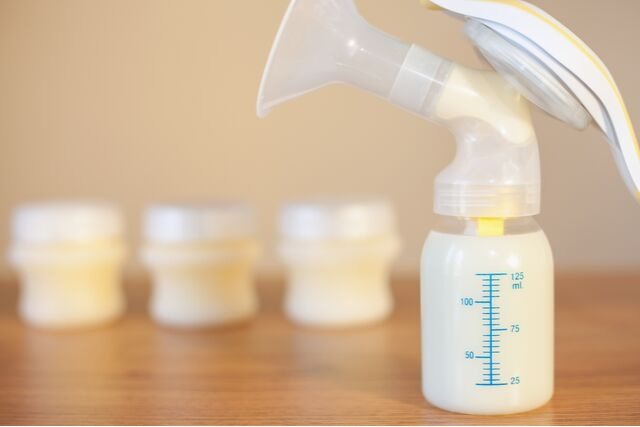Breast pumps have made life a lot easier for mothers around the world. The convenience of pumping out breast milk and storing it for later use has allowed a lot of mothers to return to work earlier than usual, while still being able to provide their babies with breast milk. However, using breast pumps has some side effects that not many people are aware of. In this article, we will talk about the side effects of using breast pumps. Read on to find out what those side effects are.
In This Article:
Benefits of Using Breast Pumps
11 Breastfeeding Pump Side Effects
How to Avoid Side Effects of Using a Breast Pump?
Benefits of Using Breast Pumps
Breast pumps are beneficial for both mothers and babies. They are also a great option for mothers unable to breastfeed for various reasons and still want to give their little one breast-milk and not use formula. Here are some of those benefits:
Control Feeding Timings
Mothers or caregivers can schedule feeding for the baby and have more control over the timing. This makes the pumping and feeding schedule more organized and gives the people involved a lot of free time.
Relieves Working or Busy Moms
Mothers working outside their homes can pump milk before they leave and the caregivers can bottle-feed the baby during the day. Breast pumps also give mothers some free time to run errands, meet friends, or pamper themselves.
Helps Increase Supply
Pumping after breastfeeding can help increase the milk supply in the breasts. Alternatively, keeping milk ready helps mothers dealing with low milk supply to.
Works Around Medical Conditions
If you have any medical conditions that prevent breastfeeding, pumping milk and bottle feeding will help.
11 Breastfeeding Pump Side Effects
Here are some side effects of using breast pumps:
Reduces Milk Supply
Pumping breast milk continuously results in a reduction in milk supply. A breast pump’s mechanism is very different from a newborn latching on their mother’s nipple and suckling. The latching of a baby is what stimulates milk production in your body. If a baby is not allowed to latch on, the milk production gradually reduces.
Read More: What is Nipple Confusion? Causes, Signs & Prevention
Depletes Nutrients of Breast Milk Due to Storage
When the baby is fed by the mother, they get all the nutrients necessary for healthy growth. Freezing or refrigerating the breast milk and reheating causes depletion of vital nutrients in the breast milk.
Can Cause Nipple and Breast Tissue Damage
Breast pumps can damage the nipples and breast tissue. The wrong setting can cause pain while pumping. Manual pumps can cause pain in both the breasts and the mother’s hands, as pumping manually is laborious and tiring.
Feeding with Both Bottle and Breast Confuses Babies
If you constantly switch between the bottle and breastfeeding, it could confuse the baby. This is due to the difference in the suckling mechanism in both cases. The baby may suck harder on the mother’s nipples, as he does with the bottle. This could also lead to sore nipples in the mother. This could also happen because the baby may not latch-on correctly while feeding directly because the baby has become used to feeding on a bottle with a rubber nipple.
Read More: Can You Breastfeed with Nipple Piercings?
It Can Cause Painful Engorgement and Excessive Let-Down
One of the electric breast pump side effects is that mothers pump too much so that they can have a big supply stored for later use. This causes the release of too many hormones in the body, which make the breasts swell and fill with too much milk. This is called engorgement and can be very painful for the mother.
Does Not Replace the Bonding Time that Direct Breastfeeding Provides
Direct breastfeeding causes a close bonding between the baby and the mother, which cannot be substituted by bottle feeding. Holding the baby in your arms and breastfeeding them causes an emotional bonding that bottle-feeding cannot replace.
A Repetitive Cycle of Washing and Sterilizing Bottles
A disadvantage of using breast pumps is that all the parts of the pump, the feeding bottles, and nipples need to be thoroughly washed and sterilized before and after each use. Another problem is that mothers may not be able to find a private place to pump when they are outside their homes. They may also not be able to find a place to store the pumped breast milk safely.
There is a Danger of Contamination
No matter how well you clean and sterilize everything, there are hard-to-reach parts of the pump and valves that can accumulate mold and bacteria. The bacteria and fungus find nutrient-rich breast milk an ideal environment to grow and multiply. They can contaminate breast milk and make the baby fall ill.
Bottle Feeding Causes Baby’s Teeth to Decay
Bottle feeding can cause the baby’s teeth to decay. If the decay has progressed, the tooth may have to be capped or removed by a dentist.
Delays Mother’s Recovery from Childbirth
When a mother directly breastfeeds her baby, the hormone oxytocin is released in her body. The oxytocin causes a contraction in the uterus, thus reducing post-partum bleeding. Breastfeeding also helps the uterus size to become normal much faster. Studies have shown that the uterus of a breastfeeding mother returns to normal size, six weeks post-delivery, whereas it takes ten weeks for the uterus to return to normal size in a mother who does not breastfeed.
Breast Pumps are Usually Expensive
Breast pumps are expensive in certain places and unfortunately, most mothers can’t afford it. So they may try to waste their hard-earned money on equipment with so many side-effects.
How to Avoid Side Effects of Using a Breast Pump?
Here are a few tips that you can follow to avoid some of the side effects of using breast pumps:
Breastfeed Your Child
Breastfeed your child. Directly feed the child as much as possible. Holding the baby close and feeding them directly increases the hormone oxytocin in your body. This hormone is responsible for the let-down effect that causes milk to be released from your body. The greater the oxytocin level is in the body, the stronger the let-down effect will be.
Replace Old Pumps
Breast pumps should be replaced every eight to ten months to make sure the baby gets uncontaminated and nutritious breast milk. Old breast pumps could develop mold in the valves or in unreachable bends which cannot be thoroughly cleaned. This can contaminate breast milk and make the baby fall sick. Old pumps also may not work as effectively as new ones. The pumping mechanism may become inefficient over time, causing the production of less breast milk.
Use an Automatic Pump
Use an electric or automatic breast pump instead of a manual one. Continuous use of a manual pump causes depletion of the mother’s milk supply. Due to this, your baby will not be able to get enough milk. A manual pump also tires your hands, as the milk has to be expressed by pumping mechanically with your hands.
Therefore, to conclude, breast pumps are not bad products, but make sure you are aware of the side-effects before buying them.
Sources:
- https://www.ncbi.nlm.nih.gov/pmc/articles/PMC2684034/
- https://www.ncbi.nlm.nih.gov/pmc/articles/PMC4920726/













